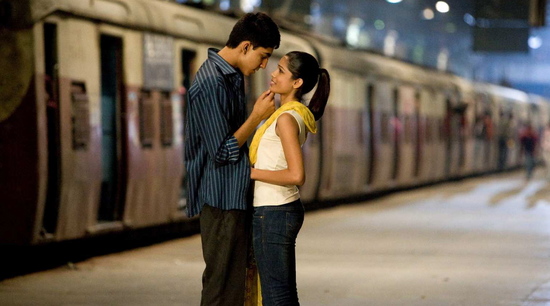For the most part, India stayed out of mainstream Hollywood movies between 1985 and 2000.
During the same time period, India’s economy was changing forever. The economic liberalization laws of the early 1990s opened up India’s doors and paved the way for its gigantic economic climb. Anyone who has lived in a major metro will tell you that the India of the 1980s looked nothing like the India of the 2000s.
India was ready for a new identity. The dominant movie images of Indiana Jones and the Temple of Doom no longer held any relevance (if they ever did). This was a new country, and it needed a new narrative to tell the world. They wanted something that showed how far they had come. They wanted a story to showcase how an entire class of New Indians had emerged.
They got Slumdog Millionaire.

Slumdog Millionaire
Statistics:
- Release Date: November 12, 2008
- Box Office Revenue: $377 million
- Ranking: #14 Worldwide for 2008
- Other Top Movies of 2008: The Dark Knight, Kung Fu Panda, Iron Man
Slumdog Millionaire is the current definitive Hollywood movie about India for the masses of people who will likely never travel to India. This movie holds a special place in my heart because it was released just before I came to India, so it truly served as part of my education. My mind was basically a blank slate when it came to modern-day India.
Audiences in the West really enjoyed the movie, and what’s not to love? It has a young hero, down on his luck, with an unwavering belief in true love. He overcomes powerful enemies to save the day and gets the girl in the end. Add in a colorful background, some social commentary, and Indian-ish lead characters, and you have an Oscar. Hooray for India! We love you!
Yet, everywhere you turned, Indians were speaking out against the movie. Why would they criticize a movie that brought a country back to the forefront of the world’s mind? Why would they not love a movie that showcases Indian dance, food, and celebrities? Why are they being so #Thinskinned about it?
Professor Shyamal Sengupta called it a “white man’s imagined India. It’s not quite snake charmers, but it’s close. It’s a poverty tour.”
Director Priyadarshan said, “The West loves to see us as a wasteland, filled with horror stories of exploitation and degradation. But is that all there is to our beautiful city of Mumbai? Let them give as many Oscars as they like. We don’t need to be impressed.”
Filmmaker Adoor Gopalakrishnan said it was a “…very anti-Indian film. All the bad elements of Mumbai commercial cinema are put together and in a very a slick way. And it underlines and endorses what the West thinks of us. It is falsehood built up on falsehood.”
What’s going on?
Let’s take a step back and see what the fuss is about. The movie tells the story of Jamal Malik, a poor Muslim boy from Mumbai. His mother is killed in the 1992 Bombay Riots where Hindu and Muslim communities attacked each other. He and his brother experience being part of a child gang, being pickpockets and becoming impromptu tour guides. All along, Jamal is trying to save his true love, Latika, from a powerful gangster.
Here are some of the subtexts that are reinforced in the movie:
Corruption is a way of life. Everyone is getting paid off and doing dirty work behind someone’s back. At nearly every stage, Jamal is confronted with a corrupt system.
India is one horrible experience after another for the poor. Jamal’s journey take him from one extreme atrocity to another with each experience dipping deeper into societal loathing.
Don’t trust the poor. Jamal and his brother engage in lots of activities that the poor have been associated with: pickpocketing, stealing shoes, refilling water bottles with dirty water, etc. And if you give to the poor, they are probably giving that money to someone else.
It’s not that Indians deny the elements those subtexts that are based in reality. Corruption, poverty, social ills, and reinforcing stereotypes come up in many Indian films as well. But it’s their country. Most outsiders never earn the right to criticize their new home. Danny Boyle even admitted that he took up the movie partly because he was unfamiliar with India. So, it becomes a little tense when a less-informed outsider gets to tell the story of India’s poor to the world.
A New Standard
So, what is India left with? Did they get the landmark movie they were hoping for? While certainly an improvement over Indiana Jones and James Bond, Slumdog Millionaire might have just updated the stereotypes.
Racial rioting replaces human sacrificing. Indian mafia dons replace psycho Thuggee priests. And exploitative child labor shifts to the streets from the mines.
While Slumdog’s stereotypes might be grounded in more reality than Indiana Jones, you can see why Indians weren’t extraordinarily thrilled with the movie or its popularity.
Slumdog Millionaire will likely continue to dominate the uninformed West’s awareness about India for years to come, so Indians must be content to live with it as the standard for now. It does offer the outsider a very brief and incomplete look at a portion of India, but it should be heavily accompanied by many other resources.
We’ll close this series next week with another modern film that looks at the oldest and most pervasive stereotype about India.





Another reason why most of us in India hated this movie is because it bunched together all the horrible possibilities of live in Indian metropolitan poverty, showed that the character and value systems of almost all people rich and poor are down in the dumps and that in a general manner the whole country (as shown in the movie) is OK with it. So, here is a country hopelessly poor, soaked in crime and sin and where the only way of redemption is for one to win a “lottery”. For generations of us, who actually have been brought up on hard work, belief in our abilities, adaptation, perseverance and modesty, to work in-spite of the flaws in Indian society (poverty, communalism, corruption etc.) and have finally felt that we have reached a stage of recognition globally, this movie came as a rude shock. It was a hobnailed boot ramming in our face and telling us that all our life-long effort is wasted. Whatever we may have achieved, it is nothing compared to the bias the western world has against us. They will continue to see us as poor, criminal and hopeless. We are their favourite bad odour, they would never like us to start smelling of the lillies.
This is from another foreigner who wrote a review when the movie came out that reflects your thoughts:
“Say an Indian director travelled to New Orleans for a few months to film a movie about Jamal Martin, an impoverished African American who lost his home in Hurricane Katrina, who once had a promising basketball career, but who — following a drive-by shooting — now walks with a permanent limp, whose father is in jail for selling drugs, whose mother is addicted to crack cocaine, whose younger sister was killed by gang-violence, whose brother was arrested by corrupt cops, whose first born child has sickle cell anaemia, and so on. The movie would be widely panned and laughed out of theatres.”
http://www.rediff.com/movies/2009/jan/29is-slumdog-worth-it.htm
“We are their favourite bad odour” – Wow. That’s worth dwelling on.